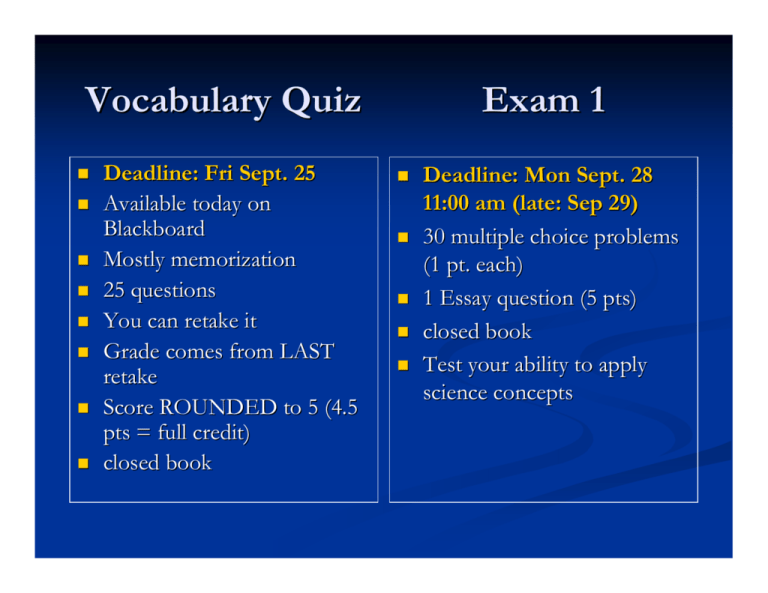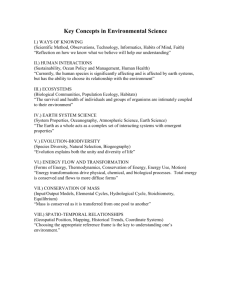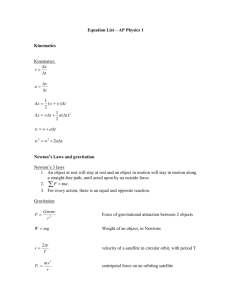Vocabulary Quiz Exam 1
advertisement

Vocabulary Quiz Deadline: Fri Sept. 25 Available today on Blackboard Mostly memorization 25 questions You can retake it Grade comes from LAST retake Score ROUNDED to 5 (4.5 pts = full credit) closed book Exam 1 Deadline: Mon Sept. 28 11:00 am (late: Sep 29) 30 multiple choice problems (1 pt. each) 1 Essay question (5 pts) closed book Test your ability to apply science concepts Exam 1 Deadline: Mon Sept., 11:00 am (5$ late: rest of Mon & Tues. Sept. 29 all day) 30 multiple choice problems (1 pt. each) 1 Essay question (5 pts) closed book Test your ability to apply science concepts Review sessions Amber Packard: review sessions Wednesday September 26 from 7:00 to around 8:30 PM & Friday 6 to 8:30 p.m. both in C215 ESC Katy & Amanda: Thursday Sept. 24 4 to 6 p.m. 377 Clyde. (Where we have class.) Adrian Rockwell: Saturday September 26 11:00a.m.1:00p.m. B002 JFSB And Tuesday 29th (late day) noon to 2 pm. Place TBA Sometimes it is hard to describe all of the motion in a system, and we want something simpler Example: Billiards Neil deGrasse Tyson, Astrophysicist speaks at Forum tomorrow at 1100 in Marriot center. Sometimes it is hard to describe all of the motion in a system, and we want something simpler A more complicated example: Power plant Chapter 8: Conservation A few fundamental quantities are conserved. That is, they neither increase nor decrease with time. They are: Mass Total charge Linear momentum Angular momentum Total energy Non-conservation In contrast, these quantities are not conserved. Temperature Kinetic energy Potential energy Internal energy Order New idea: “linear” momentum Velocity is not conserved: Imagine a big truck colliding with a compact car at rest (or in reverse for that matter). But if we include the mass of the object doing the colliding, then we get something that is conserved: momentum = (mass) x (velocity) Conservation of Linear Momentum The mass times velocity before a collision must equal the mass times velocity after a collision. If a cue ball hits a billiard ball, can it bounce straight back? A. B. C. Yes No Only if it hits it straight on. You can assume that both balls have the same mass and that the cue ball does not spin in some strange way. Conservation of Linear Momentum When a firecracker explodes in midair, the path of the center of the explosion is exactly the same as the path the firecracker would have followed if it had never exploded. Conservation of Linear Momentum at Very High Speeds From the point of view of the astronauts there is no momentum before the explosion, and equal and opposite momentum after. Conservation of Linear Momentum at Very High Speeds From the point of view of ground control the explosion stops ½ of the object but the other half is NOT moving twice as fast! At face value this violates conservation of momentum It looks like Mass has increased! We can reason either of two ways at this point: Either momentum is not conserved at high speeds or mass is not conserved. Conservation of momentum follows from position symmetry (Noether’s theorem). This makes it very solid. Mass, as it turns out, is not conserved by itself. Instead it is conserved together with energy by the relation E = mc2. Conservation of Angular Momentum Linear momentum can be used for objects moving in a straight line. “Angular momentum” can be used for objects with some rotational motion or centripetal acceleration: angular momentum = (radius) x (mass) x (velocity) Because of the conservation of angular momentum, divers can control their rotational velocity by tucking their limbs. Conservation of Energy Energy is the capacity to do something. Total energy is conserved. It can be neither created or destroyed. But energy can and does change forms or types. What forms can it have? Two major classes: Mechanical and Internal. Mechanical deals with the motion and position of large objects. Internal deals with the motion and position of atomic sized objects. Types of Mechanical Energy Kinetic K. Energy = Energy from motion E. = mv2/2 A vehicle has more kinetic energy when it is more massive or moves faster. Quiz: You are walking down the sidewalk at 3 mph. You then start running at 6 mph. By how much did your kinetic energy increase? A. B. C. D. It didn’t increase Two times Three times Four times Neil deGrasse Tyson speaks at Forum tomorrow at 1100 in Marriot center. ◄ Types of Mechanical Energy Potential Energy = Energy from position Gravitational Potential Energy = mgh (“g” is the acceleration caused by gravity) Objects have more GPE when they are more massive or farther from the earth. m h Types of Mechanical Energy Electrical Potential Energy = Energy from charge separation Objects have more EPE when the charge is greater and when the separation is greater for opposite charges or less for like charges. Transformation of Energy Gravitational Potential Energy ÅÆ Kinetic Energy A ball tossed in the air K. E. G. P. E. Total Energy Quiz: Where is the kinetic energy the greatest for a swinging pendulum? A. At the bottom of a swing. B. At the top of a swing. C. It is conserved and does not change in time. Quiz: Where is the gravitational potential energy the greatest for a swinging pendulum? A. At the bottom of a swing. B. At the top of a swing. C. It is conserved and does not change in time. Work: The Process of Transforming Energy Work is force × distance Provided the force we exert and the distance over which we exert it are in the same direction. m Gravity m distance You must go against a force Work is done here but not here Types of Internal Energy Thermal: the energy of heat Heat Transfer: Radiation Radiation The energy itself travels through space Sunrise Laser Heat Transfer: Convection Convection You heat some material, the material then moves and in the process of its motion, gives up heat. Yellowstone Hot Pot Heat Transfer: Conduction Conduction Heat moves through the material but the material itself does not move or deform. Heat Transfer Passing buckets between stationary people is like conduction. People running back and forth with buckets is like convection. Spraying directly from a well is like radiation. Types of Internal Energy Chemical Potential Energy: From atomic bonding and interactions. Lots more on this when we get to the chemistry section. Types of Internal Energy Elastic Potential Energy: From deformations Types of Internal Energy Nuclear Potential Energy: Very potent because the nuclear interaction is so strong. Examples of Energy Transformation Bullet fired into the air Car stopping at a stop sign Pole vault Making TNT Quiz: A bungee jumper falls from a bridge. What type of energy does the jumper begin with? A. B. C. D. E. Kinetic energy Electrical potential energy Elastic potential energy Gravitational potential energy None Quiz: A bungee jumper falls from a bridge. At the moment the cord is extended to its maximum unstretched length (i.e. before going taut) what is the type of energy the jumper has? A. B. C. D. Kinetic energy Electrical potential energy Elastic potential energy Gravitational potential energy E. None Quiz: A bungee jumper falls from a bridge. At the moment the cord is stretched out to its greatest possible length and the jumper is as close to the ground as possible in what form is most of the energy? A. B. C. D. Kinetic energy Electrical potential energy Elastic potential energy Gravitational potential energy Relativistic Energy & Mass-Energy Equivalence Mass and Energy together are conserved. Mass can turn into energy by the proportion of the speed of light squared. That is… E= 2 mc Public Star Party and Opening Social • Get to know the night sky When: Friday, Oct. 16 8 - 11pm Where: Big Springs Park What: Telescopes, dark sky, food • Look through BIG telescopes • View spiral structure in galaxies! • See nebulas of all types • Watch the moons of Jupiter move • And a whole lot more (no, really, we’re not just saying this - there really is a whole lot more!) Directions to Big Springs Park: Head up Provo Canyon. Take a right at Vivian Park. Go through Vivian Park and up the canyon a little over 3 miles. Look for a sign for the star party. Dress warm! Bring your friends.








